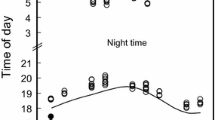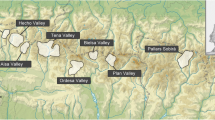Abstract
We studied the foraging behaviour of Rhinolophus hipposideros on the island “Herrenchiemsee” in Lake Chiemsee (Upper Bavaria) during summer 2001. The island offers extensively managed woodlands, highly structured open landscapes and a broad reed belt around the shore. On average the flight activity of the 6 radio tracked females outside the roost lasted 229 min per night. The home range size varied between 6.8 and 62.7 ha (mean 25.2 ha). The size of the activity centres varied between 2.8 and 8.2 ha (mean 5.3) and all except one were located almost exclusively in woodland. Within woodlands the bats did not select for specific spatial structures (different age classes of the stands or canopy densities). Only two bats regularly foraged in additional habitats outside woodlands. One of these bats used orchards and tree rows; the other foraged over artificial ponds and gardens adjoining to its woodland foraging area. We never found the bats foraging over the lake or the reed belt. Longer linear landscape elements as tree lines were used during commuting flights but there was no indication of a continuous foraging activity along these elements. Two females left the island to forage on the mainland in August after the fledging of juveniles. To reach the mainland shore, the bats had to fly at least 1.2 km across the lake.
Assuming that most foraging flights on the island occur in woodlands, a bat density in this habitat type of 0.7 bats/ha can be calculated.
Zusammenfassung
Im Sommer 2001 wurde die Jagdaktivität und die Habitatwahl der Kleinen Hufeisennase (Rhinolophus hipposideros) auf Herrenchiemsee untersucht. Potentielle Jagdlebensräume auf der Insel sind extensiv genutzte Wälder, strukturreiches Offenland und ein breiter Schilfgürtel am Ufer. Im Schnitt betrug die nächtliche Flugaktivität der 6 besenderten Weibchen außerhalb des Quartiers 229 Minuten. Die Größe der Streifgebiete variierte zwischen 6,8 und 62,7 ha (Mittelwert 25,2 ha), die Größe der Aktivitätszentren zwischen 2,8 and 8,2 ha (Mittelwert 5,3). Mit nur einer Ausnahme lagen die Aktivitätszentren fast vollständig im Wald. Dabei konnte keine Bevorzugung bestimmter Waldstrukturen (unterschiedlich alte oder dichte Bestände) festgestellt werden. Nur zwei Tiere jagten regelmäßig auch außerhalb des Waldes. Eines flog in Obstgärten und Alleen, das andere Weibchen jagte an Brunnen und Gartenanlagen, die an sein Jagdgebiet im Wald angrenzten. See und Schilfgürtel wurden nicht genutzt. An linearen Landschaftselementen wie Hecken orientierten sich die Hufeisennasen beim Flug in die Jagdgebiete, doch fand dort keine längere Jagdaktivität statt. Nach dem Flüggewerden der Jungen im August querten zwei Weibchen mehrmals den See um am Festland zu jagen. Um das andere Ufer zu erreichen, mussten sie mindestens 1,2 km über die offene Seefläche fliegen.
Unter der Annahme, dass sich die Jagdaktivität auf der Insel in Wäldern konzentriert, lässt sich für diesen Habitattyp die Dichte von 0,7 Hufeisennasen/ha berechnen.
Similar content being viewed by others
References
Anderson, D.J., 1982. The home range: a new nonparametric estimation technique. Ecology 63, 103–112.
Bontadina, F., Schofield, H., Naef-Daenzer, B., 2002. Radio-tracking reveals that lesser horseshoe bats (Rhinolophus hipposideros) forage in woodland. J. Zool. Lond. 258, 281–290.
Dixon, K.R., Chapman, J.A., 1980. Harmonic mean measure of animal activity areas. Ecology 61 (5), 1040–1044.
Friemel, D., Zahn, A., 2004. Wimperfledermaus (Myotis emarginatus). In: Meschede, A., Rudolph, B.U. (Eds.), Fledermäuse in Bayern. Eugen Ulmer, Stuttgart, pp. 166–176.
Harris, S., Cresswell, W.J., Forde, P.G., Trewelle, W.J., Wollard, Wray, T., Wray, S., 1990. Home-range analysis using radio-tracking data: a review of problems and techniques as applied to the study of mammals. Mamm. Rev. 20, 97–123.
Holzhaider, J., Kriner, E., Rudolph, B.U., Zahn, A., 2002. Radio-tracking a Lesser Horse-shoe bat (Rhinolophus hipposideros) in Bavaria-an experiment to locate roosts and foraging sites. Myotis 40, 47–54.
Issel, B., Issel, W., Mastaller, M., 1977. Zur Verbreitung und Lebensweise der Fledermäuse in Bayern. Myotis 15, 19–97.
Jones, G., Rayner, J.M.V., 1989. Foraging behaviour and echolocation of wild horseshoe bats Rhinolophus ferrumequinum and R. hipposideros (Chiroptera, Rhinolophidae). Behav. Ecol. Sociobiol 25, 183–191.
Kayikcioglu, A., Zahn, A., 2005. Zur Bedeutung von Mücken (Culiciden und Chironomiden) als Nahrung für die Kleine Hufeisennase (Rhinolopus hipposideros). Nyctalus (NF) 10 (1), 71–75.
Krull, D., Schumm, A., Metzner, W., Neuweiler, G., 1991. Foraging areas and foraging behaviour in the notch-eared bat Myotis emarginatus (Vespertilionidae). Behav. Ecol. Sociobiol. 28, 247–253.
Lutz, M., Mühletaler, E., 1997. Schutzkonzept für die Kleine Hufeisennase Rhinolophus hipposideros in den östlichen Zentralalpen (Lugnez/Valsertal, Graubünden, Schweiz). Tagungsband “Zur Situation der Hufeisennasen in Europa,” pp. 89–94.
Motte, G., Libois, R., 2002. Conservation of the lesser horseshoe bat (Rhinolophus hipposideros Bechstein, 1800) in Belgium. A case study of feeding habitat requirements. Belg. J. Zool. 132 (1), 49–54.
Reiter, G., 2002. Ökologie, Öko-Ethologie und Naturschutzbiologie der Kleinen Hufeisennase (Rhinolophus hipposideros) in Österreich. Ph.D. Thesis, Univ. Salzburg.
Reiter, G., 2004. The importance of woodland for Rhinolophus hipposideros (Chiroptera, Rhinolophidae) in Austria. Mammalia 68 (4), 403–110.
Schofield, H.W., 1996. The ecology and conservation biology of Rhinolophus hipposideros, the lesser horseshoe bat. Ph.D. Thesis, University of Aberdeen.
Weiner, P., Zahn, A., 2001. Roosting ecology, population development, emergence behaviour and diet of a colony of Rhinolophus hipposideros (Chiroptera: Rhinolophidae) in Bavaria. In: Woloszyn, B.W. (Ed.), Proceedings of the VIIIth EBRS. Approaches to Biogeography and Ecology of Bats, Vol. 1. Platan Publishing House, Krakow, pp. 231–242.
Zahn, A., Hirschberger, P., 2001. Die Dungkäferfauna von Rinder-Standweiden in Oberbayern. Zeitschrift für Ökologie und Naturschutz 9, 219–224.
Zahn, A., Weiner, P., 2004. Kleine Hufeisennase (Rhinolopus hipposideros). In: Meschede, A., Rudolph, B.U. (Eds.), Fledermäuse in Bayern. Eugen Ulmer, Stuttgart, pp. 111–126.
Author information
Authors and Affiliations
Corresponding author
Rights and permissions
About this article
Cite this article
Zahn, A., Holzhaider, J., Kriner, E. et al. Foraging activity of Rhinolophus hipposideros on the Island of Herrenchiemsee, Upper Bavaria. Mamm Biol 73, 222–229 (2008). https://doi.org/10.1016/j.mambio.2007.02.005
Received:
Accepted:
Published:
Issue Date:
DOI: https://doi.org/10.1016/j.mambio.2007.02.005




